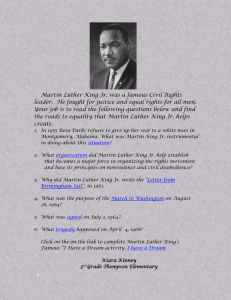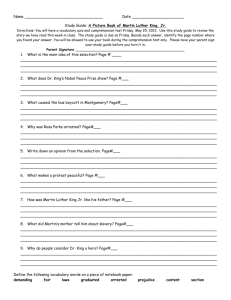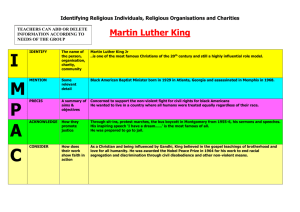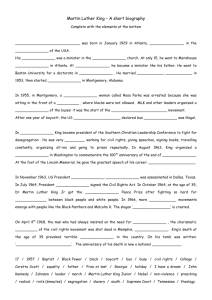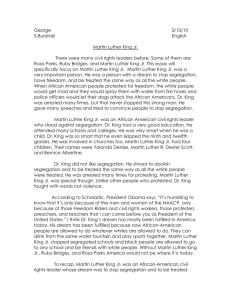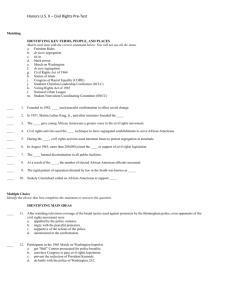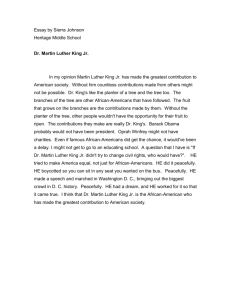Unit 16: Segregation and Civil Rights - NC-NET
advertisement
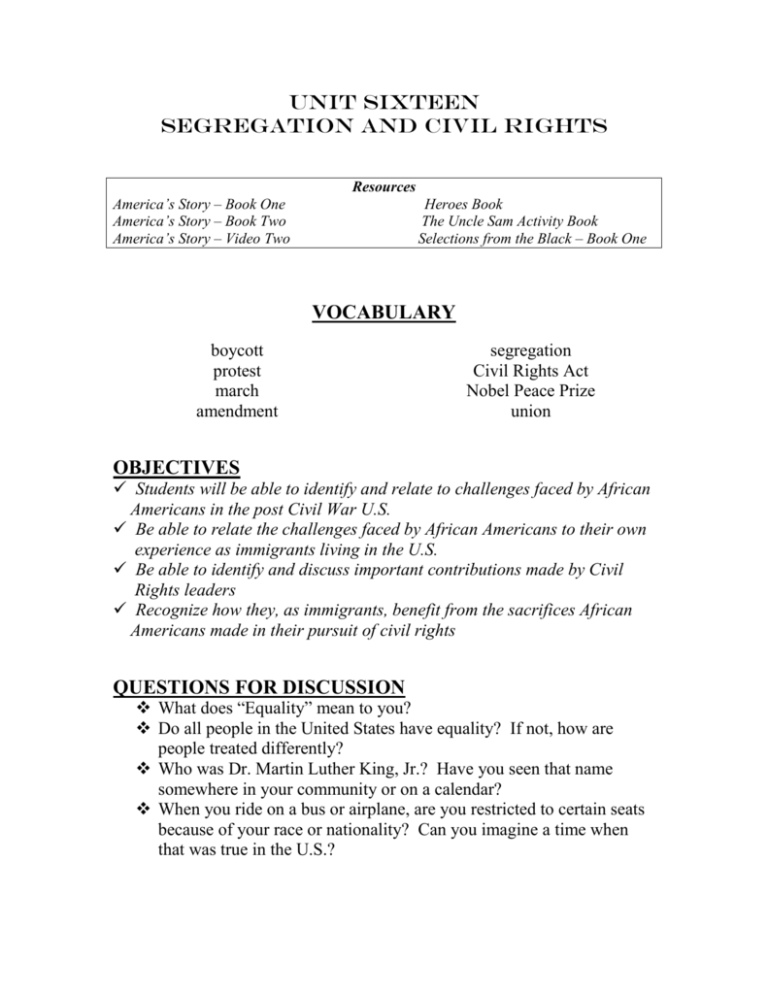
UNIT SIXTEEN SEGREGATION AND CIVIL RIGHTS Resources America’s Story – Book One America’s Story – Book Two America’s Story – Video Two Heroes Book The Uncle Sam Activity Book Selections from the Black – Book One VOCABULARY boycott protest march amendment segregation Civil Rights Act Nobel Peace Prize union OBJECTIVES Students will be able to identify and relate to challenges faced by African Americans in the post Civil War U.S. Be able to relate the challenges faced by African Americans to their own experience as immigrants living in the U.S. Be able to identify and discuss important contributions made by Civil Rights leaders Recognize how they, as immigrants, benefit from the sacrifices African Americans made in their pursuit of civil rights QUESTIONS FOR DISCUSSION What does “Equality” mean to you? Do all people in the United States have equality? If not, how are people treated differently? Who was Dr. Martin Luther King, Jr.? Have you seen that name somewhere in your community or on a calendar? When you ride on a bus or airplane, are you restricted to certain seats because of your race or nationality? Can you imagine a time when that was true in the U.S.? LESSON OUTLINE Treatment of African-Americans after the Civil War Civil Rights Leaders Martin Luther King, Jr. Cesar Chavez Susan B. Anthony Harriett Tubman Rosa Parks School Desegregation Greensboro Sit-ins Civil Rights Today Immigrants and Discrimination SUGGESTED ACTIVITIES Read America’s Story – Book Two Chapters 1 and 9 about unfair treatment of African Americans in the U.S. after the Civil War. Read America’s Story – Book Two Chapters 17 & 19 about Martin Luther King, Jr. and César Chávez, civil rights leaders working for reform for both African Americans and Hispanic immigrants Watch America’s Story Video Two video clips #7 "Dr. Martin Luther King, Jr." video clip #8 "César Chávez" The Uncle Sam Activity Book handout 28a & b Civil Rights leaders handout 29 Scrambled Song (Abraham, Martin, and John) handout 30a & b Female Civil Rights Leaders Read Heroes Book Chapter 13 “The Little Rock Nine: Battling Segregation” and do selected follow up activities in the book. Read Selections from the Black – Book One Chapter 6 “A View from the Mountaintop” by Martin Luther King, Jr. Dictation Activity Advanced students may write out the complete dictation. Beginning students may use the fill-in-the-blank dictation. Cross word puzzle FOLLOW-UP QUESTIONS/ WRITING TOPICS “Hero of the Year Award” Do you know a hero – perhaps someone in your family or from your native country? Nominate this person for “The Hero of the Year Award” and read your nomination to the class. Imagine that the National Guard had to be called to escort you to school and protect you from an angry mob outside. Would you have the courage to go to school? Would you decide to be safe and stay home? How would you react and why? In your opinion, do immigrants in the U.S. still fight a battle against discrimination? Have you or someone you know been a victim of discrimination? When and why? Segregation and Civil Rights – Dictation I remember that hot day in August 1963, when the citizens of this nation demanded equality as never before. We marched on Washington, D.C., led by Martin Luther King, Jr. and we let the world know that we would no longer tolerate segregation and discrimination. If boycotts and protests were not enough to establish civil rights for all, then the voice of thousands raised in unison was a sound that the government could not ignore. Dr. King’s speech inspired me and I believe in his dream that we will one day be judged, not by the color of our skin, but by the quality of our character. Segregation and Civil Rights Fill-in-the-blank dictation I remember that hot day in _______________ 1963, when the citizens of this nation demanded _______________ as never before. We marched on Washington, D.C., led by Martin _______________ King, Jr. and we let the world _______________ that we would no longer tolerate _______________ and _______________. If _______________ and protests were not enough to establish _______________ _______________ for all, then the voice of _______________ raised in unison was a sound that the _______________ could not ignore. Dr. King’s _______________ inspired me and I believe in his _______________ that we will one day be _______________, not by the color of our skin, but by the _______________ of our _______________. Games and Activities for: African American History and Segregation Cross word puzzle Create a crossword puzzle with one of the following free sites. http://www.puzzle-maker.com/CW/, which includes the notation: As for the puzzles you create with our Online Crossword Puzzle Maker, you are free to use them in any way you wish, even commercially. Please give credit (e.g., "Puzzle made at puzzlemaker.com"). http://puzzlemaker.school.discovery.com . Click on the pull down menu Try Other Puzzles. Select Criss-Cross Puzzle and follow the directions. Use the following information. If your puzzle instructions ask you to specify across and down, use the items in bold print for across and the remaining items for down. Answer march protest tobacco segregation Civil Rights Act Amendment Martin Luther King, Jr. Harriet Tubman Abraham Lincoln Booker T. Washington Confederacy plantations slavery Benjamin Banneker Rosa Parks boycott dream Clue Martin Luther King, Jr. led a _____ of thousands of people who walked to Washington, D.C. A _____ is when people gather together to voice their disapproval of an unfair practice. This is a typical crop grown in the South. The illegal practice of separating people of different races. Congress ended segregation and discriminatory laws by passing the _________. The 13th ________ declared that no one in the U.S. could own slaves. He was a minister who worked peacefully to end segregation in the U.S. A runaway slave who helped more that 300 other slaves reach freedom in the North. He was the 16th President of the U.S., and he declared an end to slavery. He established Tuskegee Institute for African Americans. The name the southern states chose when they left the Union. Large farms in the South where many slaves worked. The practice of forcing people against their will to serve other people What African American helped plan our capitol of Washington, D.C.? She was arrested for refusing to give up her seat at the front of the bus. A ______ is when people stop using a service or produt to voice their disapproval of it. Martin Luther King, Jr. gave his most famous speech called “I have a _____.” “Who am I?” One student stands at the front of the room with his/ her back to the black board and the teacher writes the name of a civil rights leader above his/ her head. The student will ask “yes” or “no” questions to the class in an attempt to discover whom he/ she is. EX. “Am I a woman?” “Was I a slave?” Variation Write the names of civil rights leaders, famous African Americans, etc… on slips of paper. Tape one slip of paper to each person’s back. The students then circulate asking other students “yes” or “no” questions to discover who each one is. Cultural Chronology Write cultural or historical items on note cards. Students compete in groups to put the cards in the correct order. Missing halves Distribute sentence halves taken from a reading selection. Players try to find the person who has the rest of the sentence. Point of view After hearing a description of a situation, students imagine the reactions of the different people involved. They may write down the reactions or play them out in front of the class. Spider web Draw a spider web on the board (or on paper as the game board.) Number the segments, add “Lose a turn,” “Fall back 2 spaces,” “Jump ahead three spaces,” “Go back to the beginning,” etc…. Teams roll a die and must answer a trivia question about the reading or unit of study. The first team to make it out of the web wins. Light bulbs Cut paper into the shape of light bulbs. Write trivia questions, vocabulary words, etc… on the back and on the front write 50, 75, 100 watts (ranked by the difficulty of the question to be answered.) Each player chooses a bulb and answers the question. The first team to reach 1000 points wins. Bibliography: Heroes, second edition, Jamestown Publishers, NTC/ Contemporary Publishing Group, 1999. Selections from the Black, Book One, Jamestown Publishers, NTC/ Contemporary Publishing Group, 1998.

